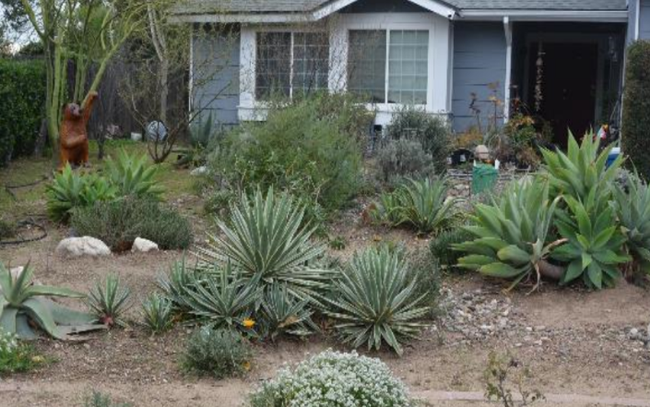By Barbara Dawson (on behalf of the UCCE San Bernardino County Master Gardener Drought Committee)
Landscape irrigation in California accounts for 1/3 to 1/2 of all residential water use. Due to the current drought and impacts of urban heat islands, planting drought and heat resistant, environmentally friendly landscape plants is important. Currently sixty-six percent of the state is now considered to be in a severe drought (drought.gov) with droughts expected to be more common and frequent over the coming decades.
Planning ahead is important! Let's reconsider the grassy cool-season lawn (tall fescue, bluegrass, ryegrass). While all living plants cools urban heat islands as they grow (through transpiration), cool season lawns require about 30% more water than warm season lawns (Bermudagrass, buffalograss) and many types of drought-resistant groundcovers. Also, since sprinkler irrigation is not as efficient as drip irrigation and much of the water applied never reaches the rootzone of the plants, even more water is often wasted. (Please remember that artificial grass, asphalt, and dark colored mulch super-heat our urban heat islands and should be avoided in inland and desert areas!)
If it makes sense in your specific situation to remove your lawn and replace it with lower maintenance plants that save time and money, what steps do you need to take to be successful? First and foremost, plan ahead. 
Once there is a plan it is time to get rid of the grass. This is no fun but keep the end goal in mind. There are several options: let the grass die (by not watering it), use a sod removal machine, or cover the grass with old carpeting or newspaper covered with mulch. Using a sod removal machine will gain the quickest results. The other options may take one to six months. Once the grass is gone check the remaining soil for sod netting although this doesn't necessarily need to be all gone before planting begins. When planting, group plants with like watering needs together (hydrozone). Check the plant tags for the height and width they'll reach when mature and make sure there's adequate space as well as their drought and heat tolerance. Consider this when planting. There will be some bald areas between the plantings at the start. Allow plenty of space if you're planning on adding trees! They should not be crowded out. Before adding new plants wait until the first ones fill out. It's ok to have a few plants that need moderate water but make sure they are in their own hydrozone.
Water regularly (once or more per week) until the plants are established (a season or two) and then go longer between waterings to let the roots dry down some and avoid root rot. Adding organic matter (such as compost) to planting sites that will not be used for trees may be useful since it helps retain water in sandy soils and enhances drainage in heavier clay soils. Check the soil to determine how often to water. Sandy soils require watering much more often than clay soils. Many natives and succulents require a fast draining soil. Continue to pull out weeds and grass clumps. After one year reassess the garden. Do you want to add more plants, take out those that are not working, add more rocks? Consider this a work in progress until you're satisfied.
One last comment. Like most gardens this will take work. But, in the end, your yard will attract pollinators and beneficial insects and you will save many gallons of water (which will result in a savings on the water bill). Southern California is an arid zone so let's create a more fitting space.



